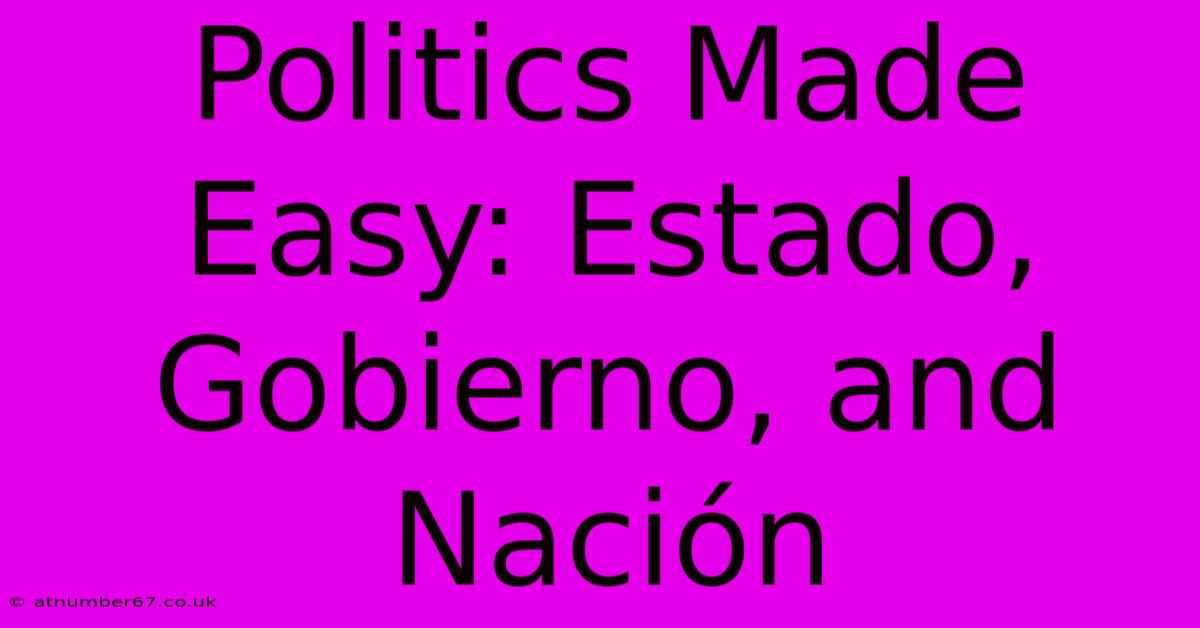Politics Made Easy: Estado, Gobierno, And Nación

Table of Contents
Politics Made Easy: Understanding Estado, Gobierno, and Nación
Politics can be confusing, a complex web of terms and concepts. But understanding the core distinctions between Estado, Gobierno, and Nación is key to grasping fundamental political structures and dynamics, especially within the context of Spanish-speaking countries and regions where these terms hold specific weight. This article will break down these three crucial concepts, making political theory more accessible and understandable.
What is the Estado? (The State)
The Estado is the most encompassing term. It refers to the permanent, sovereign entity that holds a monopoly on the legitimate use of force within a defined territory. Think of it as the machinery of government, encompassing:
- Territory: A defined geographical area under its control.
- Population: The people residing within its territory, subject to its laws.
- Sovereignty: The supreme authority within its territory, free from external control.
- Legitimate Use of Force: The right and ability to enforce laws and maintain order through police, military, and judicial systems. This includes the power to tax and regulate.
Think of the Estado as the foundation upon which everything else is built. It's the enduring structure, regardless of who's currently in power. The Estado persists even through regime changes, revolutions, or transitions of power.
Key Characteristics of the Estado:
- Permanence: It's a long-lasting institution.
- Sovereignty: It holds supreme authority.
- Monopoly on Force: It controls the means of coercion and law enforcement.
- Legal Framework: It establishes and enforces laws and regulations.
What is the Gobierno? (The Government)
The Gobierno refers to the temporary group of people who exercise the political power of the Estado at any given time. This is the acting administration, the individuals who are currently in charge of running the Estado's machinery. The Gobierno is composed of:
- Executive Branch: The President, Prime Minister, and their cabinet.
- Legislative Branch: The parliament, congress, or other legislative body.
- Judicial Branch: The courts and judges responsible for interpreting and applying laws.
The Gobierno's tenure is limited; it can be changed through elections, coups, or other means. Importantly, the Gobierno is distinct from the Estado; the latter endures while the former changes.
Key Differences between Gobierno and Estado:
- Temporality: The Gobierno is temporary; the Estado is permanent.
- Personnel: The Gobierno comprises specific individuals; the Estado is a broader entity.
- Function: The Gobierno exercises power; the Estado provides the framework for power exercise.
What is the Nación? (The Nation)
The Nación refers to a group of people bound together by a common identity. This identity can be based on:
- Shared culture: Common language, traditions, customs, and values.
- Shared history: A collective narrative and shared experiences.
- Shared ethnicity: Common ancestry or descent.
- Shared political aspirations: A desire for self-determination and shared political goals.
The Nación is a social and cultural concept, not a political one like the Estado. A Nación can exist without a State, and a State can encompass multiple Nations. The relationship between a Nación and Estado is often complex and can be a source of conflict.
The Relationship between Estado, Gobierno, and Nación:
Ideally, a strong and stable political system aligns the interests of the Estado, Gobierno, and Nación. The Gobierno effectively manages the Estado's resources for the benefit of the Nación, upholding the rule of law and protecting the rights of its citizens. However, in reality, these three entities can be in tension. For example, a Government might act against the interests of the Nation, leading to social unrest and political instability, or a Nation might be divided, leading to conflicts within the State.
Conclusion:
Understanding the nuanced differences between Estado, Gobierno, and Nación is crucial for navigating the complexities of political systems. By clarifying these fundamental concepts, we can better analyze political events, understand government structures, and appreciate the diverse ways in which societies organize themselves. This framework provides a solid foundation for deeper explorations into political science, comparative politics, and international relations.

Thank you for visiting our website wich cover about Politics Made Easy: Estado, Gobierno, And Nación. We hope the information provided has been useful to you. Feel free to contact us if you have any questions or need further assistance. See you next time and dont miss to bookmark.
Featured Posts
-
Birthday Prayer A Prayer For My Daughters Courage
Apr 16, 2025
-
What You Dont Know About Renee Montanos Age
Apr 16, 2025
-
Goodbye Breakage Hello Goddess Strength
Apr 16, 2025
-
Sridevis Daughter A Force To Be Reckoned With
Apr 16, 2025
-
Fort Worth Tornado Finding Safety
Apr 16, 2025
